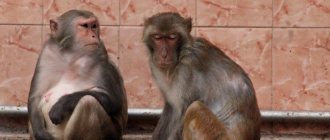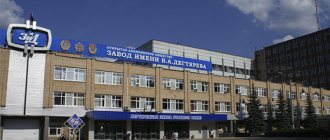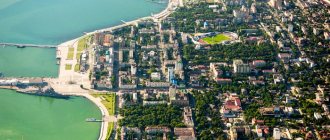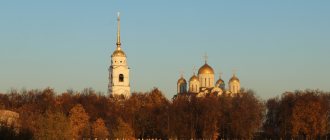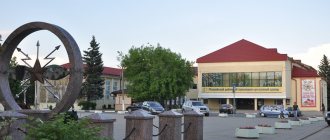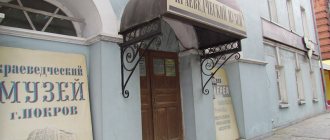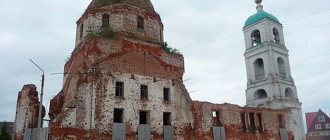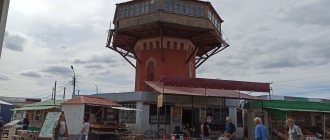The settlement, founded on the shores of the Black Sea in the 6th century BC, was initially doomed to special attention - the ancient Greeks, Romans, Byzantines, Georgians, and Russians left their mark here.
Sukhum will appeal to every tourist - beachgoers, history buffs, pilgrims, and lovers of pleasant walks and nature. Here you can not only have a great rest, but also have something to see and visit, where to take a walk and where to go in the vicinity of the city. Read more in our material about the most important attractions and entertainment of the capital of Abkhazia.
If you are going to Sukhum with children, be sure to read our review guide about living in Sukhum with a child, as well as in general about the features of a family holiday in Abkhazia.
Excavations of the fortress of Dioscuria
Address: excavations are located in close proximity to the Sukhumi Seaport. Opening hours: 24 hours a day, every day. Cost of visiting: free.
This area is covered in legend and rumors: locals willingly share stories about the divine origin of the city (as a reward for a righteous life, God gave the Abkhazians a city between the sea and the slopes of the mountains) and about the ambitions of the Ancient Greeks to recreate the capital of their empire on local lands. In addition, mention of the fortress can be found under a variety of names: Black Sea Atlantis, Sukhum-Kale, Sebastopolis.
Dioscuri is the nickname of two Greeks, twin brothers, who stood at the origins of the foundation of the settlement on the shores of Sukhumi Bay. This is the same name, according to historians, that Sukhum bore about 2,500 years ago. There is evidence that it was the Greeks who built the fortress.
At the same time, being located in the seaside part of the city, the fortress originates... under water. Scientists have discovered flooded city buildings in the same architectural ensemble as the fortress. From this it was concluded that the city was destroyed by a landslide or sank to the bottom under the influence of an earthquake, which gave it the name - Black Sea Atlantis (sometimes the name Sukhumi Atlantis is found).
Since the middle of the 19th century, there was a garrison and a prison within the perimeter of the fortress, organized by Russian troops, and now there is the famous restaurant of national cuisine “Dioscuria”.
Sukhum: where to go and what to see
Sukhum is the main city of Abkhazia, the capital of the Land of the Soul. Don’t even think about calling it in the old fashioned way, in the Georgian manner - Sukhumi, the Abkhazians will immediately not like you very much for this.
The population of Sukhum is about 60,000 people. And this is the largest city in Abkhazia.
I have never seen traffic jams in the city. But here you come across expensive cars and houses like this:
Sukhum is located 110 km from the Psou checkpoint, but visiting it is not included in the “Golden Ring of Abkhazia” route, which is the most popular among bus excursions.
And this is not at all because the city is uninteresting and there is nothing to see there. Gagra and Ritsa in one day , and still have time to get to Sukhum .
You should set aside at least half a day to explore Sukhum. And then you will enjoy exploring the city.
I like Sukhum because when you come to it, you don’t feel like a tourist. Here there is the least intrusive attention to you from merchants and other persons interested in your wallet.
At the same time, Sukhum has everything tourists need: hotels, restaurants, coffee shops, souvenir shops, an embankment for walking .
How to build a route around the city to see all the interesting places? Here is our proven route around the city .
Freedom Square and Government House
Freedom Square
— the main square
of Sukhum
. It contains the abandoned building of the Council of Ministers of the former Soviet republic of Abkhazia.
For me, this is the most impressive abandoned building in Abkhazia. A huge building in the very center of the city, a kind of ghost house. Not a single tourist leaves Sukhum without taking a photo against its background.
But when we drove past it for the last time, we were surprised to find that the building was covered with a cloth (look at the Video):
Someone in Abkhazia seems to have become ashamed of this attitude towards architecture...
Freedom Park is located directly opposite. But there is nothing special about it. Therefore, 5 minutes to examine it will be enough for you. In addition, there are other places in Sukhum where it is pleasant to walk among green spaces. For example, Sukhum Botanical Garden .
Sukhumi Botanical Garden
I only managed to hit it the third time. The first two it was already closed, although its opening hours are from 9 a.m. to 6 p.m. But in the low season this schedule is not always maintained.
This garden is worth visiting if only because it is the oldest botanical garden in the Caucasus. 1838 is the date of the creation of the botanical garden, laid out by the doctor Bagrinovsky in the Sukhum fortress. Let me remind you that Russian troops recaptured it from the Turks in 1810 and began to develop the territory.
Thus, the military department tried to plant fruit and ornamental plants and even vegetables in the reclaimed sections of the coastline, which at that time included Sukhum. This was done to keep the soldiers busy during their free time from hostilities, as well as to provide the garrison with fresh vegetables and fruits. The task of the Sukhumi Botanical Garden was to provide such points with seeds and plant seedlings.
In Soviet times, the agricultural function of the garden gave way to a decorative one. The Sukhumi Botanical Garden began to serve as an arboretum.
One of its main attractions is the 250-year-old Caucasian linden tree, which grew here even before the garden was founded.
The diameter of its trunk is 3 m. In 1877, the tree was cut down by the Turks, but it did not die. Continuing to grow, the linden reached a height of 20 m. But during the hurricane of 1987, it was again unlucky - most of the crown was demolished. Despite this, the tree has recovered, blooms and bears fruit.
On this weekday we walked in the park almost alone, and our impressions of the garden only benefited from this:
Visiting the garden is paid: 250 rubles per adult and 50 rubles. for a child from 7 to 14 years old.
The garden area is small. His inspection took us 30-40 minutes, so you won’t have time to get tired, even if you are with children. Overall, one of the places I recommend visiting in Sukhumi.
Embankment of Mahadzhirs
And my favorite place to walk in Sukhum is the Makhadzhirov embankment.
Every resort town must have a promenade. Sukhum is no exception. Its embankment is named after the Mukhajirs. These were people who moved to Turkey (voluntarily or forcibly), protesting against the regime of the tsarist government.
The embankment was built in the late 19th and early 20th centuries. Ancient buildings of that time are still preserved here.
The Makhadzhirov embankment is considered the most picturesque place in Sukhum. On it you can see traces of the Soviet era, such as this Amra cafe:
And also new monuments appear here. For example, 2011 was marked by the opening of a monument to the boy Chik, the main character of F. Iskander’s book “Chick’s Childhood” (its events unfold in Sukhumi). Chick holds in his hand a chicken that he could not kill, despite his mother's request. As the author of the sculpture commented, this young man symbolizes the city of Sukhum itself for him.
In 2012, another sculpture was installed - of a little girl Nika sitting next to a gramophone. Like the boy Chick, she was the heroine of the above-mentioned work by Fazil Iskander.
Before the revolution, the embankment was called Mikhailovskaya, but then it was divided into two parts - the embankments of Dioskurov and Mahadzhirov .
In Soviet times, the Abkhazia Hotel, located in the center of the embankment, was very popular, so it became the hallmark of Sukhum. Currently, this hotel has been such a spectacle for years:
Perhaps someday this situation will change for the better...
Theater with a fountain
Abkhaz State Drama Theater named after. S. Chanba is located on the corner of the street. Pushkin and the Makhadzhirov embankment.
Briefly, the history of this building looks like this: in 1912, the Grand Hotel with 30 seats and a theater with 670 seats, owned by the Sukhumi merchant of the 1st guild I.M. Aloisi, were built on this site. The hotel housed a restaurant, a garage with rental cars, an Olympia cinema, a casino and two shops. Since 1921, the Aloisi Theater was renamed the 1st State Theater of Abkhazia, and the Grand Hotel in the 30s. began to be called “Bzyb”. In 1942, both buildings burned down, but in 1952 they were restored in their modern appearance.
The entrance to it is decorated with this beautiful arch:
The square in front of the theater is decorated with a fountain with mythical griffins, from whose mouths streams of water flow:
On hot summer days there are usually people who want to climb into the fountain and cool off. But we usually just take pictures in front of it.
Old fortress Sukhum
Another attraction that can be seen while walking along the embankment is the ruins of the Sukhumi fortress.
The fortress or Sukhum-Kale is the first structure on the territory of the city of Sukhumi, built by the Turks around the 16th century. For a long time, the entire city consisted of this very fortress.
In fact, not much remains of the fortress now - it is a wasteland measuring 100 x 140 meters where almost nothing is visible except a couple of walls:
and a structure on stilts in the sea:
And we spent a whole 15 minutes examining all this, incl. It took 10 minutes to take photos and videos.
And immediately after that we went to our favorite place in Sukhum - the Nartaa restaurant (52 Makhadzhirov embankment). Lunch for three cost us 750 rubles.
Ruins of Bagrat Castle
How to get there: you need to get to the street. Akirtava, and from it - to the street. Bagrata, which leads to the fortress. Opening hours: 24 hours a day, every day. Cost of visiting: free.
This is a powerful fortification erected in the 10th-11th centuries. and named after its founder - Monarch Bagrat. The once majestic fortress has preserved to this day only fragments of ten-meter walls, but the view from the mountain is unsurpassed - here is the sea, Sukhumi in full view, and the original Abkhazian surroundings. An ancient underground tunnel leading to the mouth of a mountain stream has also been preserved here.
Sights of Sukhumi with photos
The most famous and ancient architectural monument in Sukhumi is the Sukhumi Fortress, you can see the photo below. It was built by the Romans and called “Sebastopolis”, which means “Holy City”. Today, only ruins remain of the fortress, which symbolize the history of the city.
Among the significant architectural monuments one can also highlight the Great Abkhaz Wall . It was erected during the Byzantine period of history. The wall stretched 160 km in length and consisted of small towers 8-12 m high. Now ruins remain of the wall, but some towers are well preserved.
Moving on to an overview of the sights of modern Sukhumi, first of all I would like to highlight the Botanical Garden . It occupies a leading place among arboretums around the world. It contains plants from subtropical regions around the world. The garden contains more than 5,000 varieties and varieties of plants. The main exhibit is the Caucasian linden tree, which is more than 250 years old.
An amazing place that was once world famous is the Research Institute of Experimental Pathology and Therapy of the Academy of Sciences of Abkhazia, known as the Monkey Nursery , which is located on Mount Trapezium. There are more than 300 individuals of various monkey species from Africa, Asia and South America.
Are you going to Georgia? Write to [email protected] - we will create the optimal travel route for you. Come and we will try to make your vacation unforgettable! You can get a free consultation by phone: +7 or +995 555 566 540
On the territory of the institute you can visit the primatological museum; there is also a monument to a monkey erected here.
The attractions of the resort Sukhumi are the Makhadzhirov embankment and the Dioskouri embankment . One embankment smoothly transitions into another, in fact it is one embankment, they are even paved with the same masonry.
The embankments are the main recreational area for city residents and vacationers. From here you have an excellent view of the sea, and on the other side of the embankment there are old colorful buildings. The atmosphere is complemented by exotic plants that grow on the embankment.
In Sukhumi, as throughout Georgia, gambling is allowed, so the city has several casinos designed for both visiting tourists and the local population.
Sukhumi Botanical Garden
Address: st. Chavchavadze, 20. Phone: . Open to the public: 9.00-18.00, daily. Ticket price: 200 rub. – adult, 140 rub. – preferential and for children.
Over almost 200 years of history, the garden has gathered a whole collection of plants that do not by nature belong to the climate of Abkhazia - more than 5,000 representatives of flora from all corners of the planet. It is customary for tourists to pay special attention to the three-meter-tall Caucasian linden tree - a beauty at the age of 250 years, which grew long before the garden was founded.
Research Institute of Experimental Pathology and Therapy (Sukhumi Monkey Nursery)
How to get there: the nursery is located on the slope of Trapezia Mountain, getting there on foot takes at least half an hour up a steep hill, so it’s better to catch a driver on Gumskaya Street, who will take you up for 70-100 rubles. Phone: 226 45 17. Open to the public: from 10.00 to 18.00, daily. Ticket price: 150 rub. – adult, 100 rub. – preferential and for children.
The first primatological center created in the Soviet Union and the oldest existing today was created in 1920 as a station for experiments, primarily medical.
The location was chosen deliberately: it is in Sukhum that the similarity with the tropical climate allows primates to exist most organically in an initially unnatural habitat.
The research activities of the institute continue today: the main focus is on research into stress factors, military operations and strong emotional shocks on the immune properties of the body. Abkhaz scientists transfer the results of research and experiments conducted with the participation of more than 300 monkeys of several dozen species to the plane of the human body, developing treatment methods and specialized drugs.
Over the years of its existence, the primates living at the institute managed to fly into space (in 1978), test vaccines against hepatitis A and measles, and test drugs for the treatment of hair problems.
All test monkeys can be seen in the nursery . There are still about three hundred of them, although only 9 species. The animals live in cages, you can feed them, and children will certainly appreciate watching the primates play.
What to see in Sukhumi with children
Abkhaz State Museum
The state museum is located in a spacious building in the center of Sukhum. By the way, the exhibits can be seen not only inside the building. On the territory of the museum there is the grave of the artist Alexander Shervashidze, a dolmen from Escher and stone sculptures.
Inside the museum there is a huge collection of attractions dating back to prehistoric times. Also here you can “visit” the traditional home of a Caucasian family and learn more about local traditions.
Address: D. Gulia street, building 61
Apery
In 1927, a monkey nursery opened in Sukhum. It was created to study human diseases. In fact, all residents of the nursery were experimental materials. By the way, 12 monkeys from the Sukhumi nursery became astronauts.
Now nothing reminds me of the laboratory. You can see the monkeys and feed them.
Address: Mount Trapezium, NIIEPiT
Annunciation Cathedral
Address: st. Abazinskaya 75 (at the intersection of Abazinskaya and 4 March streets). Telephone:
A classic architectural monument erected in the period 1909-1915 in honor of St. Nicholas the Wonderworker. Under the influence of regime changes, it was renamed several times. It has changed dioceses more than once; to this day it is the central cathedral of the Sukhumi-Abkhaz and Pitsunda dioceses; services here are conducted in four languages at once: Abkhaz, Georgian, Greek and Old Church Slavonic.
Abkhaz State Museum
Address: Leon Ave., 22 (central part of Sukhumi). Phone: +7 840 6-43-15. Open to the public: from 10.00 to 15.00, every day except Saturday and Sunday. Ticket price: 60 rub. – adult, 30 rub. – preferential and for children.
One of the richest in terms of historical value and the content of its collections, the Caucasus Museum opened its first exhibition in the 60s of the 19th century. Now the number of exhibits exceeds 100,000, many of them are witnesses not only to the history of Abkhazia itself and its indigenous inhabitants, but also of other countries, cultures and eras - Ancient Egypt and Rome, Sasanian Iran, the Byzantine Empire.
Interesting exhibits : a bust of ancient times, raised from the bottom of Sukhumi Bay, an ancient Greek marble wall, fragmentarily presented in the exhibition, Assyrian and ancient Greek armor dating from the 5th-6th centuries. BC.
The area adjacent to the museum also deserves attention - in the park you can see a complex of residential buildings that clearly demonstrate the life and history of Abkhazians of different eras.
